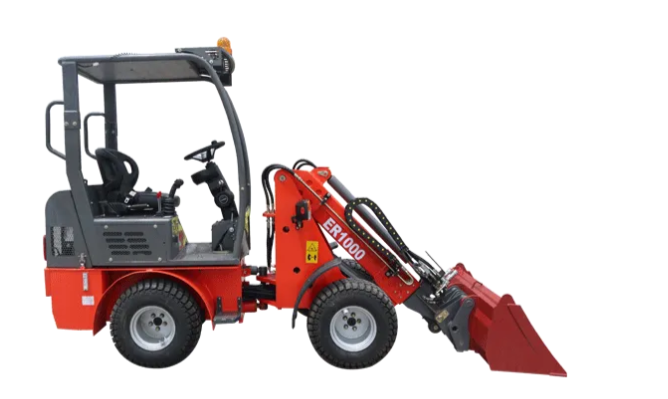Ultimate Guide to Mini Telescopic Loaders: Compact Powerhouses for Every Job
Mini telescopic loaders have become essential tools across various industries, offering the versatility of a telehandler with the compact size needed for confined spaces. From construction sites to agriculture and landscaping, these loaders provide impressive lifting capabilities in a smaller footprint. In this guide, we’ll cover what a mini telescopic loader is, its key features, types, and benefits, as well as tips for choosing the best one for your needs.
1. What is a Mini Telescopic Loader?
A mini telescopic loader is a compact machine equipped with a telescopic boom that extends forward and upward. These loaders are ideal for lifting, loading, and moving materials, often used in construction, farming, and various maintenance applications. Their small size and maneuverability make them suitable for tight spaces, while the telescopic boom adds flexibility for reaching higher or more challenging areas.
2. Key Features of Mini Telescopic Loaders
a. Compact Design
- Fits in Small Spaces: These loaders are designed to navigate tight areas that larger machines cannot reach.
- Lightweight: The smaller size makes them less likely to cause ground damage, perfect for soft or delicate surfaces.
b. Telescopic Boom
- Extended Reach: The telescopic boom enables loaders to reach high places, load onto trucks, or stack materials efficiently.
- Adjustable Height and Angle: Operators can precisely control the boom’s extension, making it useful for various applications.
c. High Maneuverability
- 4-Wheel Drive: Many models come with 4-wheel drive, allowing for excellent traction on uneven terrain.
- Small Turning Radius: This feature makes it easy to navigate obstacles and tight corners.
d. Versatile Attachments
- Wide Range of Attachments: Mini telescopic loaders are compatible with attachments like buckets, forks, grapples, augers, and more.
- Quick Change Systems: Many models offer quick change systems for easy attachment swaps, saving time and increasing productivity.
e. Safety Features
- Stability Systems: Stability monitoring helps keep the loader balanced, reducing the risk of tipping.
- Operator Protection: Many loaders come with protective cabs or operator stations with safety features such as rollover protection.
3. Types of Mini Telescopic Loaders
a. Wheeled Mini Telescopic Loaders
- Best for Hard Surfaces: Wheeled loaders work well on paved or hard-packed surfaces.
- Higher Speeds: Often faster than tracked versions, making them suitable for work on solid ground or when needing to cover distance.
b. Tracked Mini Telescopic Loaders
- Better for Rough Terrain: Tracks provide excellent traction on soft, muddy, or uneven ground.
- Lower Ground Impact: Tracks distribute the machine’s weight, making them gentler on surfaces and ideal for delicate grounds.
c. All-Terrain Mini Telescopic Loaders
- For Extreme Environments: All-terrain versions are designed for very challenging environments, such as hilly or rocky terrain.
- Enhanced Stability: These models are built with extra safety and stability features for tough jobs.
4. Benefits of Using a Mini Telescopic Loader
a. Improved Efficiency
- Mini telescopic loaders allow for faster loading, lifting, and transporting, which enhances productivity and saves time.
b. Versatility for Various Applications
- With the ability to swap out attachments, these loaders can be adapted to multiple tasks, from digging and trenching to loading and unloading.
c. Cost-Effective and Fuel Efficient
- These machines are typically more fuel-efficient and less expensive to operate and maintain than full-sized loaders, making them a practical investment for smaller projects.
d. Reduced Damage to the Ground
- The compact size and often lighter weight result in less ground damage, ideal for delicate workspaces or landscaped areas.
5. Top Applications for Mini Telescopic Loaders
- Agriculture: Moving hay bales, feed, and supplies; cleaning barns; loading feed or seed.
- Construction: Loading and unloading materials, transporting supplies, lifting pallets, or reaching high areas.
- Landscaping: Moving soil, gravel, and other materials; installing trees; clearing debris.
- Warehousing and Storage: Lifting and moving heavy items, loading trucks, and organizing warehouse goods.
6. Leading Brands for Mini Telescopic Loaders
Some popular brands for mini telescopic loaders include:
- Bobcat: Known for durability and versatility in compact machinery.
- JCB: Offers a range of loaders with advanced control and comfort features.
- Manitou: Well-regarded for agriculture and construction, offering robust, high-capacity models.
- Avant Tecno: Specialized in compact, multi-functional loaders with high maneuverability.
7. Maintenance Tips for Mini Telescopic Loaders
a. Regular Inspections
- Conduct daily checks on tires/tracks, hydraulic systems, and attachment connections to ensure everything is in good working condition.
b. Keep It Clean
- Regularly remove dirt and debris from the telescopic mini loader, especially around the boom and attachments, to prevent wear and tear.
c. Lubrication
- Proper lubrication of moving parts will keep the machine running smoothly and prolong its lifespan.
d. Monitor Fluid Levels
- Check and maintain hydraulic fluid, engine oil, and coolant levels to avoid breakdowns or costly repairs.
e. Battery Care
- Ensure the battery is fully charged and connections are clean, particularly if the machine is not in use for extended periods.
Frequently Asked Questions (FAQs)
Q: Can a mini telescopic loader be used indoors?
A: Yes, mini telescopic loaders are compact and can operate indoors, provided there’s adequate ventilation for fuel-powered models or use of electric loaders.
Q: Are mini telescopic loaders good for rough terrain?
A: Tracked or all-terrain mini telescopic loaders are ideal for rough terrain, offering greater stability and traction.
Q: How much can a mini telescopic loader lift?
A: Lifting capacities vary by model but typically range from 1,500 to 4,000 lbs. Always check the specifications of the loader to match your needs.
Q: What attachments can I use with a mini telescopic loader?
A: Many attachments are available, including forks, buckets, augers, grapples, and pallet forks, allowing you to adapt the loader for various tasks.
Q: How often should I service a mini telescopic loader?
A: Regular maintenance should be performed daily, with comprehensive servicing every 250-500 hours depending on usage intensity and manufacturer recommendations.
Conclusion
Mini telescopic loaders combine power, reach, and flexibility in a compact size, making them invaluable for many industries. Whether you’re in agriculture, construction, or landscaping, these loaders are designed to make material handling easier and more efficient. By selecting the right model based on lifting capacity, terrain compatibility, and attachment needs, you’ll maximize productivity while keeping operational costs manageable.






